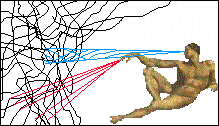
Physics Contributions to Medical Advances
Physics has brought remarkable advancements to healthcare, with innovations that have significantly improved diagnostics and treatment processes. These innovations illustrate how physics principles are applied in real-world medical scenarios, enhancing patient outcomes and transforming the practice of medicine.
One such innovation is radiation therapy, a crucial tool in the battle against cancer. Over 60% of cancer patients receive some form of radiotherapy during their treatment journey (Schaue and McBride 2015). The principle behind this therapy hinges on using ionizing radiation to damage the DNA of cancer cells, thus inhibiting their ability to divide and grow (Jackson and Bartek 2009; Baskar et al. 2012). This makes cancer cells especially vulnerable to radiation compared to normal cells. Radiotherapy can be administered through various methods, including external beam radiation and brachytherapy, depending on the type and location of the tumor (Minami-Shimmyo et al. 2012). Innovations in this field, such as real-time imaging and advanced dose distribution techniques, have increased the precision and effectiveness of treatments, though challenges like resistance in certain cancers and normal tissue toxicity remain (Mi et al., 2016).
Another significant advancement driven by physics is ultrasound imaging. Ultrasound technology employs high-frequency sound waves to create images of the inside of the body, providing a non-invasive and highly effective diagnostic tool. This method is particularly beneficial because it does not use ionizing radiation, making it a safer option for patients, including pregnant women. The ability to visualize organs, tissues, and even blood flow in real time has revolutionized the way doctors diagnose and monitor conditions ranging from gallstones to fetal health. The development of portable ultrasound devices has further expanded access to this technology, allowing for immediate diagnosis and treatment decisions in various settings, from hospitals to emergency response units in remote areas.
Laser surgery represents another area where physics has made substantial contributions to healthcare. Lasers provide a high degree of precision which is invaluable in surgical procedures. This level of precision minimizes damage to surrounding tissues and promotes quicker recovery times for patients. Procedures like LASIK eye surgery have become commonplace, restoring vision to many without the need for glasses or contact lenses. Additionally, laser techniques are employed in cosmetic and dermatological surgeries, removing skin lesions, tattoos, and wrinkles with minimal scarring. Advances in laser technology continue to improve the safety and efficacy of these procedures, making surgeries less invasive and more accessible.
Nanotechnology is perhaps one of the most exciting and transformative fields influenced by physics. It has opened new horizons in drug delivery systems, offering solutions to challenges that traditional methods could not overcome. Nanoparticles can be engineered to carry drugs directly to the target site, reducing side effects and improving therapeutic outcomes. For instance, gold nanoparticles exhibit unique properties that make them suitable for photothermal therapy, where they are used to heat and destroy cancer cells selectively (Mi et al., 2016). The enhanced permeability and retention effect of nanocarriers enables them to penetrate tumors more effectively while sparing healthy tissues. This approach ensures that drugs are delivered precisely where needed, maximizing their impact and minimizing collateral damage.
Furthermore, nanotechnology facilitates personalized medicine by allowing for the customization of drug delivery systems based on the specific needs of individual patients. Researchers are exploring ways to use nanomaterials to create smart drug delivery systems that release medication in response to specific physiological triggers. These advances promise a future where treatments are tailored to the genetic and molecular profile of each patient, improving outcomes and reducing adverse effects.
Final Analysis
In this series, we’ve explored the fascinating ways in which physics principles apply to biological systems, revealing a deep connection that advances both fields. We’ve seen how thermodynamics explains cellular energy production, while molecular motors demonstrate the conversion of chemical energy into mechanical work within cells. The study of photosynthesis through quantum mechanics has shown us how plants achieve remarkable efficiency, and statistical mechanics has provided insights into genetic evolution. These examples underscore the powerful synergy between physics and biology, offering new perspectives and driving scientific progress.
As we delve deeper into the intersection of these disciplines, it’s evident that biophysics is a rich field with tremendous potential for discovery. From understanding the fine details of DNA and protein structures using techniques like atomic force microscopy and X-ray crystallography, to the innovative applications of biomimicry in technology and medicine, the fusion of physics and biology continues to yield groundbreaking advancements. This journey not only enhances our comprehension of life’s molecular underpinnings but also paves the way for future innovations that can transform various aspects of science and everyday life.
Reference List
Bhushan, B. (2009, April 28). Biomimetics: lessons from nature–an overview. Philosophical Transactions of the Royal Society A: Mathematical, Physical and Engineering Sciences. https://doi.org/10.1098/rsta.2009.0011
Mengesha, W. G. (2024). Cutting-edge physics driven advancements in medical industry. American Journal of Modern Physics, 13(2), 27-33. https://doi.org/10.11648/j.ajmp.20241302.13
Mi, Y., Shao, Z., Vang, J., Kaidar-Person, O., & Wang, A. Z. (2016, December). Application of nanotechnology to cancer radiotherapy. Cancer Nanotechnology. https://doi.org/10.1186/s12645-016-0024-7
The Best 50 Biomimicry Examples and Inventions of All Time. (2022, November 25). Www.learnbiomimicry.com; Learn Biomimicry. https://www.learnbiomimicry.com/blog/best-biomimicry-examples




